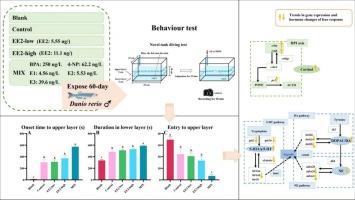Effect of environmentally relevant concentrations of estrogens on the fear-like response of male zebrafish
IF 4.3
3区 环境科学与生态学
Q2 BIOCHEMISTRY & MOLECULAR BIOLOGY
Comparative Biochemistry and Physiology C-toxicology & Pharmacology
Pub Date : 2025-09-19
DOI:10.1016/j.cbpc.2025.110354
引用次数: 0
Abstract
Environmental estrogens (EEs), diversely and widely distributed, are established to affect fish behaviour. However, information on the effects of EEs mixtures at environmentally relevant concentrations on fish fear-like responses is currently limited. In this study, adult male zebrafish were exposed to MIX (EEs mixtures at environmental concentrations: BPA, 250 ng/L; 4-NP, 62.2 ng/L; E1, 4.56 ng/L; E2, 5.53 ng/L; E3, 39.6 ng/L), as well as to EE2-low (5.55 ng/L, with oestrogenic potency equivalent to that of MIX) and EE2-high (11.1 ng/L) for 60 days. After exposure, fear-like response was evaluated using a novel tank diving test with alarm substance (AS) stimulation. Our data revealed that only MIX significantly delayed the onset time to upper layer, increased the duration in lower layer and reduced the frequency of entry to upper layer, indicating exacerbated fear-like responses in MIX-exposed fish. Additionally, for the response tests, plasma cortisol levels and brain 5-HIAA (5-hydroxyindoleacetic acid) and DOPAC (3,4-Dihydroxyphenylacetic acid) levels were elevated while brain serotonin (5-HT), dopamine (DA), and norepinephrine (NE) levels were reduced in MIX-fish. Furthermore, significant alterations were also observed in the gene mRNA expression involved in hypothalamus-pituitary-interrenal (HPI) axis and 5-HT/DA/NEergic systems in brain. These findings suggest that MIX may exacerbate fear-like responses in male zebrafish by disrupting the HPI/cortisol axis and the 5-HT/DA/NEergic pathways, potentially affecting fish population structure and leading to severe ecological consequences.

环境相关雌激素浓度对雄性斑马鱼恐惧样反应的影响。
环境雌激素(EEs),种类繁多,分布广泛,已确定影响鱼类的行为。然而,关于环境相关浓度的EEs混合物对鱼的恐惧样反应的影响的信息目前有限。在本研究中,成年雄性斑马鱼暴露于MIX(环境浓度为:BPA, 250 ng/L; 4-NP, 62.2 ng/L; E1, 4.56 ng/L; E2, 5.53 ng/L; E3, 39.6 ng/L),以及ee2低(5.55 ng/L,雌激素效力与MIX相当)和ee2高(11.1 ng/L) 60 天。暴露后,用一种新型的有报警物质刺激的水箱潜水试验来评估恐惧样反应。我们的数据显示,只有MIX显著延迟了进入上层的时间,增加了进入下层的时间,减少了进入上层的频率,表明MIX暴露的鱼的恐惧样反应加剧。此外,在反应测试中,混合鱼血浆皮质醇水平和脑5-HIAA(5-羟基吲哚乙酸)和DOPAC(3,4-二羟基苯基乙酸)水平升高,而脑5-羟色胺(5-HT)、多巴胺(DA)和去甲肾上腺素(NE)水平降低。此外,下丘脑-垂体-肾间轴(HPI)和大脑5-HT/DA/NEergic系统相关基因mRNA的表达也发生了显著变化。这些发现表明,MIX可能通过破坏HPI/皮质醇轴和5-HT/DA/NEergic通路,加剧雄性斑马鱼的恐惧样反应,可能影响鱼类种群结构并导致严重的生态后果。
本文章由计算机程序翻译,如有差异,请以英文原文为准。
求助全文
约1分钟内获得全文
求助全文
来源期刊
CiteScore
7.50
自引率
5.10%
发文量
206
审稿时长
30 days
期刊介绍:
Part C: Toxicology and Pharmacology. This journal is concerned with chemical and drug action at different levels of organization, biotransformation of xenobiotics, mechanisms of toxicity, including reactive oxygen species and carcinogenesis, endocrine disruptors, natural products chemistry, and signal transduction with a molecular approach to these fields.

 求助内容:
求助内容: 应助结果提醒方式:
应助结果提醒方式:


